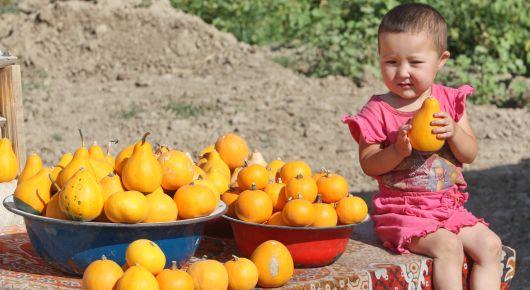Infographics gives an easy overview on food security and nutrition in Kyrgyzstan

Every 15th person in Kyrgyzstan suffers from malnutrition, that is, the human diet contains insufficient amounts of nutrients or a person consumes excess amounts of food. Every 14th child under the age of five is overweight, and every 6th adult is obese.
Around the world, issues of ensuring food security and nutrition quality are fundamental for achieving the Sustainable Development Goals (SDGs) until 2030, in particular SDG 2, Zero hunger. Kyrgyzstan, like the rest of the UN member countries, is actively working in this direction.
FAO, in the framework of the project funded by the Russian Federation “Developing Capacity for Strengthening Food Security and Nutrition in selected countries in the Caucasus and Central Asia”, analyzed the situation with food security and nutrition in Kyrgyzstan through a number of indicators of social and food systems and prepared infographics, available in English and Russian, which illustrates data interrelation over time, and also demonstrates their trends.
The profile contains tables, graphs, charts, and other visual tools related to malnutrition, stunted growth, overweight in children, obesity and anemia among women of reproductive age. In addition, the information reflects the situation by provinces with respect to growth failure and overweight, including indicators of trends since 2006. The infographics uses the food system approach and provides information on establishing favourable conditions for the food environment through the production, processing, storage and processing of food products, trade and marketing, describing general guidelines for healthy, processed, and ultra-processed foods.
Since 2006, for example, indicators of children with stunting decreased in all provinces of the country except the Jalal-Abad region, and indicators of overweight increased in the Batken, Chui and Jalal-Abad provinces.
The increase in agricultural production, the enrichment of flour and salt with vitamins and micronutrients, the introduction of a hot school meals programme, as well as other social protection measures for vulnerable groups in Kyrgyzstan – all these undoubtedly had a positive impact on improving food security and nutrition of the population. Thus, significant progress has been made in reducing the stunting of children under five years of age, as well as malnutrition.
However, despite the observed improvements in the nutritional status of children under five, the pace of progress and its scale remain insufficient. In addition, the sustainable achievement of SDG 2 by Kyrgyzstan can be undermined by the increase in the proportion of children and adults suffering from overweight and obesity, as well as by a consistently high level of anemia among women of childbearing age.
But what is the food system and why is it so important to achieve food security and nutrition for everyone? The food system covers the entire spectrum of actors and their interrelated activities in production, processing, transportation, consumption and disposal of food products. Issues related to the food system include management and economics of food production, their sustainability and environmental impact, and the impact of food on human health and social well-being of the population.
Ending hunger, like the other SDGs, requires an integrated approach that will allow us to step back from the usual measures and attract previously uninvolved actors, for example, each of us. In this regard, the food system can serve as a tool to look at the issue of food security and nutrition quality broadly and deeply enough to accelerate progress towards achieving the SDGs.
The food security and nutrition infographics profile of the Kyrgyz Republic was prepared by using the statistics of the latest FAO report on the State of Food Security and Nutrition in the World and the Kyrgyz Multi-Indicator Cluster Survey 2019.
17 March 2020, Bishkek, Kyrgyzstan
